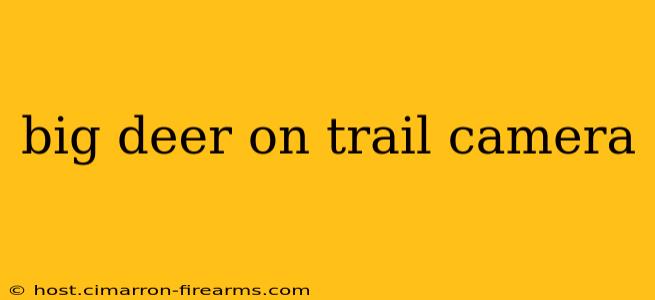Spotting a majestic deer on your trail camera is a thrilling experience for any nature enthusiast. But identifying the type of deer and improving your chances of capturing these incredible images requires understanding their behavior and habitat preferences. This guide will help you identify some common large deer species often caught on trail cameras, and offer tips to boost your chances of capturing stunning wildlife photos.
Identifying Large Deer Species on Your Trail Camera
Several large deer species could grace your trail camera's lens. Accurate identification hinges on careful observation of key physical characteristics. Here's a breakdown of some commonly encountered large deer:
1. White-tailed Deer (Odocoileus virginianus)
- Distinguishing Features: The most widespread large deer in North America, white-tailed deer are easily identifiable by their characteristic white tail, which is often held high and fanned out when alarmed. Bucks possess large antlers that vary in size and shape depending on age and genetics. Does (females) lack antlers.
- Habitat: White-tailed deer are adaptable and inhabit diverse environments, from forests and woodlands to grasslands and even suburban areas.
- Trail Camera Tips: Place your cameras near known deer trails, salt licks, or food sources. Consider using scent lures to attract deer.
2. Mule Deer (Odocoileus hemionus)
- Distinguishing Features: Mule deer are named for their large, mule-like ears. Their antlers are generally larger and more branched than white-tailed deer antlers, often with a distinctive "fork" near the top. Their rump patch is usually white and more sharply defined than that of white-tailed deer.
- Habitat: Mule deer prefer open woodlands, brushy areas, and mountainous regions. They're less frequently found in dense forests.
- Trail Camera Tips: Focus on placing cameras in open areas with good visibility. Look for trails near water sources in mountainous or brushy terrains.
3. Elk (Cervus canadensis)
- Distinguishing Features: Elk are significantly larger than white-tailed or mule deer, with massive antlers in mature bulls (males). Their coat is typically reddish-brown in summer and grayish-brown in winter. They have a characteristic bugle call.
- Habitat: Elk inhabit forests, grasslands, and open areas with access to water sources. They often prefer mountainous regions.
- Trail Camera Tips: Target areas with abundant vegetation and water sources, especially in higher elevations. Using trail cameras with a wide field of view will help capture these large animals.
4. Red Deer (Cervus elaphus)
- Distinguishing Features: Red deer are known for their reddish-brown coat in summer, which turns a darker brown or grayish-brown in winter. Bucks possess large, imposing antlers that are typically more palmated than those of mule deer.
- Habitat: Habitat varies by region but generally includes forested areas, grasslands, and open woodlands.
- Trail Camera Tips: Similar to elk, consider placing cameras in open areas with good visibility in forested and grassland areas.
Maximizing Your Trail Camera Success
Beyond species identification, optimizing your trail camera setup can significantly increase your chances of capturing those elusive big deer images:
Camera Placement & Settings:
- Strategic Location: Place cameras along known animal trails, near water sources, salt licks, or areas with abundant food sources.
- Sensor Sensitivity: Adjust the sensitivity to avoid triggering false alarms from wind or other non-animal activity.
- Night Vision: Ensure your camera has effective night vision capabilities for optimal nighttime photography.
- Battery Life: Use high-capacity batteries and consider solar panels for extended operation.
Attracting Deer:
- Mineral Licks: Legally placing a mineral lick in your target area can attract deer.
- Food Plots: Planting food plots can draw deer to your area, but regulations vary by location, so check local laws.
- Scent Lures: Commercially available deer attractants may increase your chances of attracting deer to your camera's range.
By understanding the characteristics of different large deer species and employing smart trail camera strategies, you can significantly improve your chances of capturing incredible images of these magnificent animals. Remember always to respect wildlife and adhere to all local regulations when setting up and operating your trail cameras.

